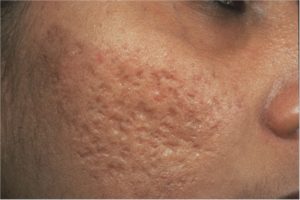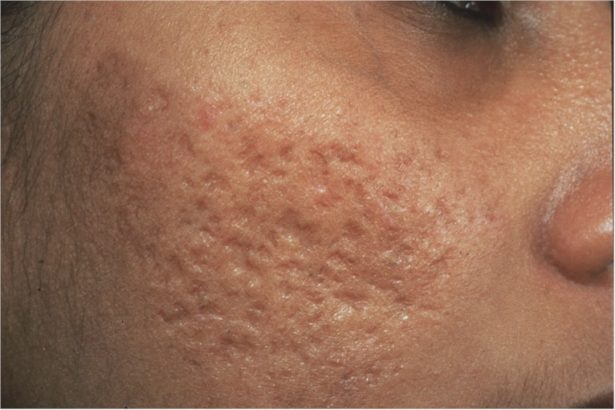Acne is one of the most common problems that is faced by teenagers all around the world, and often adults can be affected as well. When a pimple or acne lesion heals it leaves behind a red mark or at times a hyper pigmented mark on the skin. This could go away with time but there are a lot of occasions where the marks persist. Thus acne can lead to acne scars. Below is a simple breakdown of various acne scars types.
The acne scars types could be broadly classified or put into two types:
- That causes loss of tissue which is called atrophic, which is called a Pitted acne scar type
- Which is caused by excess tissue also called hyper trophic, which is also called Pigmented acne scar type.
Being more specific acne scar types would fall into one of these four types:
- Ice pick scars – Pitted
- Boxcar scars – Pitted
- Rolling scars – Pitted
- Keloid scars – Pigmented
Ice Pick scars

The name says it all. A scar resembling a scar left behind because of an attack by an ice pick. They are small, narrow and very deep. It is so deep that they penetrate the skin or the dermal layer. They show their presence when a cyst or a similar blemish shows up onto the skin. The tissue is then destroyed leaving back a scar that resembles an ice pick injury. Common treatments for this type of scar are punch grafting or punch excision.
Boxcar scars

The appearance for these scars is round or oval depressions. They have steep vertical sides. Like an ice pick scar they are pitted but are wider than ice pick scars. They are developed when the skin lose collagen. When collagen is lost some tissue on the skin gives way. This in turns makes the skin looking pitted. Common treatments for this type of scar are dermal fillers or laser resurfacing.
Rolling scars

The appearance is of a wave-like skin on an otherwise smooth skin. They are developed when lose tissue develop between the epidermis and the subcutaneous tissue that is below. This causes pulling of the epidermis and the skin appears to be of the wave form or the rolling form at that particular spot. Common treatments are subcision.
Keloid scars

Not very common and is mostly found on the torso of men. They appear as if a lump of mass has accumulated at the acne spot. They are caused by over production of collagen. Common treatments are steroids, tape or injections that could flatten or soften the tissue. They are often similar to hypertrophic acne scars.
Whatever the treatment for any of the acne scar types make sure that the problem is met head on and is solved before it wreaks havoc in the minds. Prevention of acne is one of the better remedies to avoid acne scars. The acne scar types could be mild or severe but definitely not to be overlooked as it may cause depression or loss of self confidence in some teens.
